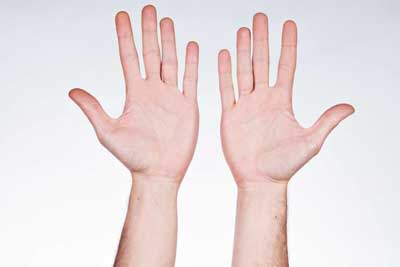| Posted: Sep 25, 2017 |
New technique uses light to separate mirrored molecules
(Nanowerk News) Molecules made in labs often have a downside that nature mysteriously avoids. The problem is that many molecules are chiral, which means they have an asymmetrical structure. A consequence of chirality is that when we synthesize a chiral molecule we also often make its doppelganger, a mirror image of the intended molecule. The two may look similar but, like the right and left hand, they aren't interchangeable.
|
 |
| Left- and right-handedness is appropriate for humans but problematic for synthesized molecules. Stanford researchers are developing a solution.
|
|
Depending on the handedness, the molecule limonene smells like oranges or turpentine, ibuprofen can be four times more potent and thalidomide either treats morning sickness or leads to severe birth defects.
|
|
"Approximately 50 percent of drugs and 30 percent of agrichemicals are chiral, which means they can be left- or right-handed. Of those, more than 90 percent are sold as mixtures of both handed molecules because it's so hard to separate them," said Jennifer Dionne, associate professor of materials science and engineering at Stanford University. The normal chemical methods of separating molecules - to keep the good version and weed out the bad - are expensive, time-intensive or inefficient.
|
|
Dionne's lab has now shown one approach that holds promise for separating chiral molecules. It involves a nanostructured filter that, when illuminated with a laser, attracts one handed specimen while repelling its mirror image. The team published this technique in Nature Nanotechnology ("Nanoscopic control and quantification of enantioselective optical forces").
|
A light handshake
|
|
Focused light can change the momentum of an object. This effect has been used to create incredible tools, called optical tweezers, which allow scientists to manipulate particles with highly focused beams of light. (It was his work with optical tweezers that earned Steven Chu, professor of physics at Stanford and professor of molecular and cellular physiology in the Stanford School of Medicine, the Nobel Prize in Physics in 1997.) Although the idea of tweezing apart chiral forms has seemed appealing, many of the molecules we want to target are too small to be pulled apart by optical forces directly.
|
|
Yang Zhao, a postdoctoral fellow in the Dionne lab, overcame that weakness by creating a nanostructure that allows circularly polarized light to interact more strongly with small specimens. The light path in the nanostructure maps a spiral in one direction but not the other. Once the chiral light has passed through this path, it interacts with molecules that complement its shape and pulls those downward.
|
|
The researchers tested their prototype by measuring the forces exerted on chiral specimens. They built a tool called a chiral optical force microscope, which combines the optical tweezers with an atomic force microscope (AFM), a tool capable of resolving the chemical structure of a single molecule. A chiral AFM tip served as the chiral specimen and, at the same time, mapped out the forces specific to the handedness of the tip. They showed that the optical forces produced by their tweezers are strong enough to separate certain chiral molecules.
|
Building the optical filter
|
|
The team has not yet tested the tweezers on actual chiral molecules, but Zhao has begun quantifying the forces they are able to apply to DNA and certain proteins. These chiral molecules have a specific handedness in nature but can be either handedness if produced in a lab.
|
|
The next step will be assembling their tweezers into a sort of filter that can separate two forms of a drug or other molecules.
|
|
"We will put many of these nanostructures on a microfluidic chip where a drug of interest can be introduced," said Zhao. "If it works as we want it to, we should be able to have the drug separated upon illumination."
|
|
In addition to sorting drugs to make them safer or more effective, the researchers think their tweezers could be put to other uses, such as monitoring the folding or unfolding of a protein or enabling light-mediated synthesis of chiral chemicals.
|

